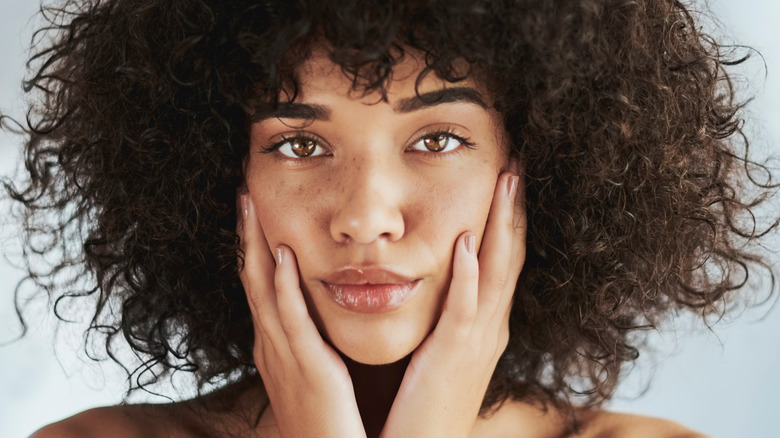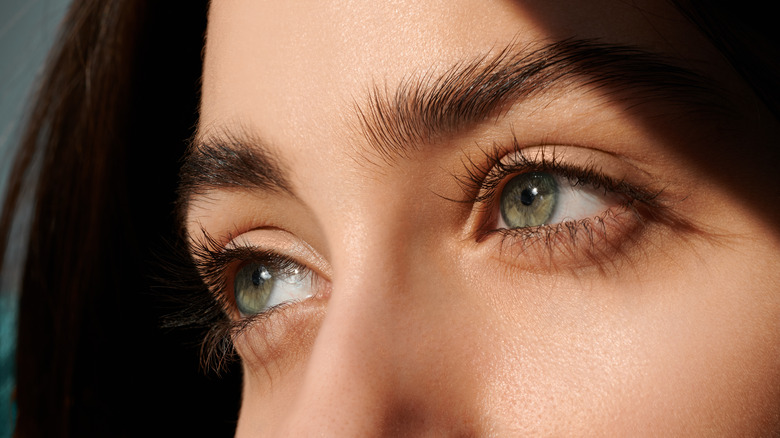Unexpected Side Effects Eye Color Can Have On Your Health
People often refer to the eyes as the window to the soul. As it turns out, this popular saying holds more relevance than previously thought. More specifically, it's been shown that eye color can provide insight into the likelihood of developing certain health conditions, and it's related to the amount of melanin you produce, too.
Similar to how your skin's natural hue correlates to how much melanin or pigment your body produces, your eye color is also influenced by melanin. In other words, those who produce greater amounts of melanin have darker-colored eyes, while people with less melanin have lighter eyes. The different levels of melanin production found in brown, green, or blue eyes can also dictate the risk of developing certain medical conditions. For instance, the specific hue of our irises is associated with skin conditions, eye health, and vision-related sensitivity. Eye color may even predict your risk of cancer. Now, let's find out what the experts have learned about this unexpected connection between eye color and health factors.
Uvular melanoma and eye color
Uvular melanoma is the "most common" type of cancer that grows in the eye, and it's often observed in older individuals, per a 2020 study published in the International Journal of Molecular Sciences. As stated in the study, the risk of developing uvular melanoma increases if you have light-colored eyes. Research revealed that those with green, hazel, blue, and gray irises are more susceptible to uvular melanoma than their brown-eyed counterparts.
As with other forms of cancer, frequent sun exposure puts you at greater risk. People with lighter eyes produce less pigment in their eyes, which, in turn, causes increased sensitivity to sunlight. Therefore, those with light-colored eyes are encouraged to wear sunglasses while spending time outdoors. However, not all sunglasses offer ample protection from harmful ultraviolet A (UVA) and ultraviolet B (UVB) rays, so ensure your sunglasses or contacts block both types of sun rays before heading outside.
The association between eyes and skin
Studies have shown that iris color is also associated with two major skin conditions: melanoma and vitiligo. "Melanoma is a life-threatening cancer that can spread to other parts of the body," ophthalmologist Dr. John T. Lind shared with Glam in an exclusive chat in 2023. According to Dr. Lind, people with lighter eyes, notably blue and green eyes, are also at greater risk of developing skin cancers outside of melanoma. For instance, a 2021 study published in the journal Cancer, Causes, and Control revealed that the risk of basal cell carcinoma (BCC) and squamous cell carcinoma (SCC) was more prevalent in male participants with hazel, blue, and green eyes compared to those with darker eyes.
On the other hand, the opposite is true for vitiligo, an autoimmune disease characterized by patchy losses of skin color. A 2012 letter published in the journal Nature found that vitiligo is more common in Caucasian individuals with darker eyes than those with lighter eyes. Specifically, those with blue eyes exhibited the least risk of vitiligo, while people with brown eyes displayed the highest risk. That said, wearing sunscreen daily is the best way to lower the risk of skin cancer and applies to all individuals, regardless of eye color.
Cataracts are often seen in dark-eyed individuals
Brown eyes are one of the most common eye colors across the globe. In fact, almost half of the entire population of the United States has brown eyes. Brown-eyed folks also have a leg up over those with lighter-colored eyes where the possibility of eye cancer and melanoma are concerned. However, that's where the advantages end, as individuals with darker eyes are more susceptible to developing a different type of health issue: cataracts.
Cataracts obfuscate the eye lens, resulting in foggy vision that progresses over time and eventually lowers your vision. A 2000 study published in the American Journal of Ophthalmology indicates that people with dark brown eyes are more likely to develop cataracts than individuals with blue, hazel, or green eyes. As such, experts recommend taking precautions to prevent cataracts by wearing sunglasses to protect your eyes from direct exposure to sunlight.
Age-related macular degeneration
Eye color also influences the rate of age-related macular degeneration (AMD), a condition that affects the part of the retina known as the macula. Most older individuals who experience vision loss do so as a result of AMD, and, more specifically, it can lead to a degradation of your central vision. In other words, those with AMD have normal peripheral (side) vision, but they're unable to see objects clearly if they're at the center of their range of vision.
What's more, a 2000 study published in Transactions of the American Ophthalmological Society found that those with dark-colored irises had a lower incidence of AMD than those with light-colored irises. The basis for this theory ties into sun exposure. "UV light is a risk factor for macular degeneration. Extra light that gets into the eyes of people with light-colored irises may cause them to have more retinal degeneration," Christopher Quinn, secretary-treasurer of the American Optometric Association, told The Healthy. However, other studies, like a 2014 one published in the International Journal of Ophthalmology, indicate the correlation between lighter eyes and AMD is insignificant and requires further research.
What downsides come with green eyes specifically?
In our exclusive chat in 2023, ophthalmologist Dr. John T. Lind revealed several disadvantages of having green eyes. For instance, green-eyed individuals may experience sensitivity or difficulty with vision on sunny days. "Patients with lighter colored irides tend to be more light sensitive," Dr. John T. Lind told us. "This is likely due to the lack of melanin of the iris and patients having greater glare due to light scatter." Sensitivity is also associated with other medical conditions, such as glaucoma and macular degeneration. To combat sensitivity, Dr. Lind suggests wearing yellow-tinted glasses instead of the usual gray-tinted option.
Of course, scheduling regular visits to your eye doctor is also critical to maintaining your eye health. "This is perhaps more important in patients with green eyes due to the increased risks of eye-related and systemic associations," Dr. Lind added. As with all light-colored eyes, remember to keep your eyes protected from the sun to lower your risk of uvular melanoma.





